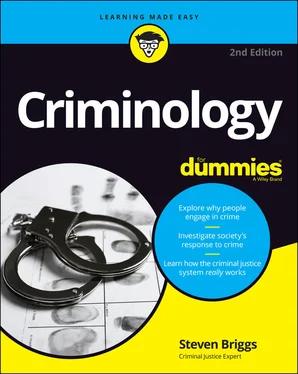Of course, not everyone acts rationally. Human beings are prone to doing stupid things, even when they know they’re stupid. And then, of course, you can’t forget the impact of drugs and mental illness. A person high on methamphetamine probably won’t do a very good job of analyzing potential risks and rewards.
Pointing the finger at society
Sometimes people make rational choices to engage in crime because their values are significantly different from those of mainstream society. For example, a gangbanger may rationally choose to commit assault to gain status within his gang. How does a person develop such antisocial values?
Criminologists have developed a number of theories to explain society’s role in crime. Social disorganization theory, for example, asserts that the structure of a neighborhood is strongly correlated to the amount of crime in that neighborhood. Where social structures are in decay, more crime is likely to occur. Poor schools, high unemployment, and a mix of commercial and residential property are some of the indicators of social disorganization.
Strain theory contends that everyone in society has generally the same goals and ambitions. But some people aren’t able to achieve those goals because they lack opportunity, attend poor schools, or have few positive role models, for example. In response, they resort to crime to achieve their goals. In other words, the frustration, or strain, of not achieving their goals leads them to commit crime. A variety of strain theories focuses on different causes of frustration.
Yet another theory, called the social learning theory, contends that criminals learn the skills, attitudes, and behaviors that lead to crime from the people they hang out with. Under this theory, a person’s peer group and family are instrumental in shaping the values that lead them to criminal or law-abiding behavior.
Other explanations for crime come from a collection of theories known as social control theories. Generally, these theories argue that crime is exciting and fun and provides immediate gratification, so most people would become criminals if not for a variety of “controls” that restrain the urge to commit crime. These controls may be external, such as family, schools, church, and the social bonds related to these organizations. Or they may be internal, such as self-discipline and strong self-esteem. In neighborhoods where institutional controls are weak, more crime occurs.
Blaming mental and physical defects
It’s increasingly clear that genetics, diet, brain chemistry, and even the environment can play a role in causing a person to commit crime.
Adoption studies have confirmed a genetic link between criminal parents and criminal conduct by their offspring. But these same studies also show that the environment created by the parents raising the children has an impact on the children’s criminal conduct. Thus, criminologists recognize that genetics are just part of the picture.
Other studies have shown that a poor diet can lead to learning disabilities, attention deficit/hyperactivity disorder, and depression, all of which are linked to greater potential for criminal behavior.
And, of course, personality disorders and mental illnesses may create a greater likelihood of criminal behavior. For example, a large percentage of people in prison have an antisocial personality disorder, which generally means they’ve engaged in a pattern of behavior that violates the rights of others.
Waging a War against Crime
Society fights crime with three levels of police: Local, state, and federal. Each level has different responsibilities, but they all join forces when it comes to fighting organized crime.
Of the 18,000 police agencies in the United States, most of them are local agencies, which means they’re city police or county sheriffs. These agencies handle most of the emergency calls for police services. In addition to responding to 9-1-1 calls, however, local police patrol the streets and enforce traffic laws. In fact, the only interaction most people have with a cop is getting pulled over for a traffic violation.
Although local agencies can range in size from one officer to thousands, most departments have the following categories of cops:
Patrol officers respond to 9-1-1 calls and drive the streets to try to discourage crime with their presence.
Sergeants typically supervise five to ten officers.
Detectives conduct criminal investigations. Rather than just responding to a 9-1-1 call and writing a report, a detective typically is assigned more complex cases that require longer-term investigations. A smaller police department may have just a general detective unit, while a larger department may have detectives who specialize in specific types of crime, such as homicide.
Management includes lieutenants, captains, and the chief of police or sheriff.
In Chapter 16, I discuss the functions of all these cops in detail.
Getting the feds involved
Although the federal government has over 65 different federal agencies with law enforcement personnel, the vast majority of federal officers work for agencies I’m sure you’ve heard of, including the following:
Federal Bureau of Investigation (FBI)
Drug Enforcement Administration (DEA)
Bureau of Alcohol, Tobacco, Firearms and Explosives (ATF)
Homeland Security Investigations (HSI), which has taken on the responsibility of immigration and customs enforcement
Secret Service
U.S. Marshals Service
Internal Revenue Service (IRS)
These agencies enforce federal criminal laws, which are criminal laws passed by the U.S. Congress. (Local police agencies typically enforce local or state laws.) Each of these agencies focuses on its area of specialty, with the FBI having broader authority to get into more types of crime. An officer with a federal agency is usually called a special agent and conducts complex, long-term investigations. Special agents don’t respond to 9-1-1 calls or enforce traffic laws. If you’re intrigued by life as a fed, look at Chapter 17where I give you a brief overview of the major federal law enforcement agencies.
Working together in task forces
Because organized crime frequently crosses the territorial boundary of one police agency, local, state, and federal cops often come together to form task forces, which fight a specific type of crime. Most commonly, officers from different agencies work together on drug or gang task forces. For example, when a drug mule carries dope from one city into another, the task force has authority in each town to conduct surveillance and make arrests.
One of the greatest benefits of task forces is that they encourage information sharing between different agencies. When agencies combine their information about a particular organized crime group, they often create a much better picture of the threat and are then able to devise a strategy to investigate and eliminate that threat. Because so many different police agencies are working toward the same goal of public safety, cooperation among them is crucial, and task forces help to foster that cooperation.
Bringing Criminals to Justice
When police catch a criminal, that person enters a large, complex system that is set up to make sure that individual’s constitutional rights are protected at the same time that society as a whole is protected.
After police make an arrest, a prosecutor must determine whether or not to file criminal charges. (At the local level, a prosecutor is usually known as an assistant district attorney or county prosecutor. At the federal level, prosecutors are called assistant U.S. attorneys. ) After reading a police officer’s report, if a prosecutor decides to file charges, he drafts a charging document, sometimes called an information or an indictment, which lists all the criminal charges against the defendant.
Читать дальше












